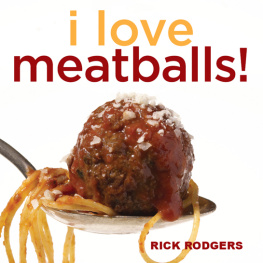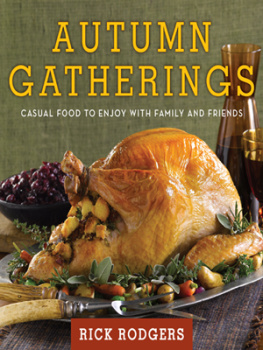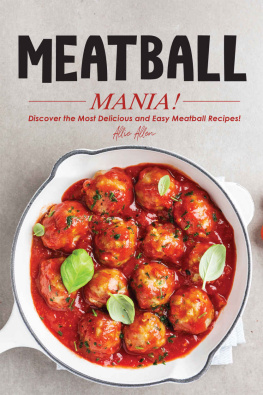I Love Meatballs! Text copyright 2011 Rick Rodgers. Photos copyright 2011 Ben Fink. All rights reserved. No part of this book may be used or reproduced in any manner whatsoever without written permission except in the case of reprints in the context of reviews.
Andrews McMeel Publishing, LLC
an Andrews McMeel Universal company
1130 Walnut Street, Kansas City, Missouri 64106
E-ISBN: 978-1-4494-1942-4
Library of Congress Control Number: 2011921503
www.andrewsmcmeel.com
Design: Holly Ogden
Photography: Ben Fink
Food Stylist: Susan Ottaviano
Prop Stylist: Dani Fisher
Cover design by Tim Lynch
Cover Photograpy by Bin Fink
Author photo by Brain Dobson
www.rickrodgers.com
Attention: Schools and Businesses
Andrews McMeel books are available at quantity discounts with bulk purchase for educational, business, or sales promotional use. For information, please e-mail the Andrews McMeel Publishing Special Sales Department:
acknowledgments
When you look at a cookbook, you see the authors byline. This isn't fair, as a cookbook is hardly a solo effort. Many talented, hardworking people assisted me in the creation of this book. Countless hundreds of meatballs were consumed in the name of research!
First of all, thanks to my fellow meatball lover and editor, Jean Lucas, for her dedication to the cause. I hope Ive finally provided her with the perfect meatball recipe. Kirsty Melville, our intrepid leader at Andrews McMeel, also jumped on the meatball bandwagon, and she inspired us to think outside of the meatball box. Thanks to Holly Ogden for the vibrant book design, and to Tammie Barker for getting the word out.
This book is another happy collaboration between photographer Ben Fink and me. Thank you, Ben, for always making my food look so luscious. Bens crews are always made up of the best people in the business, and food stylist Susan Ottaviano and prop stylist Dani Fisher continued the tradition.
In my kitchen, very little would get accomplished without the sister I never had, Diane Kniss, who has cooked by my side for more years than we dare to count. And Patrick Fisher, taster extraordinaire, personally vetted all of the recipes in this book, and assured me that a freezer full of leftover meatballs is a dream come true. My friends and food professionals Carolyn Bnflavi and Diane Phillips, and Carolyns husband, Gabor, contributed their best recipes and I appreciate their tasty input. My incomparable agent, Susan Ginsburg, generously offered her indispensable friendship and advice.
introduction
How can a food be comforting and retro, yet cutting-edge and hip all at the same time? The meatball has deftly managed this balancing act. Ever since humans discovered that chopping tenderized tough meat, and that rolling the mixture into balls made for a tasty and easy-to-eat way to cook them, meatballs have been served up by everyone from Italian grandmothers to of-the-moment chefs. I Love Meatballs! shares over fifty of my favorite recipes for the worlds best meatballs for every occasion, from family meal to dinner party.
Like so many of us, my love affair with meatballs started at the family kitchen table. Every American family has a trustworthy meatball recipe, whether for spaghetti and meatballs, Swedish meatballs, or another specialty. And, even better, meatballs can be economical and relied upon to satisfy a hungry table of diners while staying within the tightest budget.
Every cuisine has its own version of meatballs. Greeks love their herb-seasoned keftedes. Latino cooks adore albndigas as tapas or in soup. Germans cant live without Kgisberger Klopse (poached meatballs in a caper sauce). Nor would the Danes want to go too long without delicate veal-and-pork frikadeller. Swedish meatballs in a light brown sauce are just as popular here as they are in their native country!
Kofta (and similar-sounding words) means meatball to both Middle Eastern and Indian cooks, as the word comes from the Persian word for to grind and has traveled far and wide. Chinese cuisine features meatballs both small (as part of the dim sum menu) and large (lions head). The Vietnamese serve meatballs on noodles or rice, or tucked into sandwiches.
Meatballs can be grilled and dipped, simmered and sauced, fried and nibbled. They can be retro (people make fun of the fifties sweet-and-sour meatball until they try one) or upscale (try chopping the meat at home for truly remarkable meatballs), and used in soups, stews, sandwiches, and casseroles. And they are all here. While some cooks will argue that a meatball must have meat in the form of beef, pork, veal, or lamb, I have included some seafood- and poultry-based balls. Not only are they delicious, they are lighter than their red-meat cousins in all senses of the word, and that can be as welcome as the heartier versions. Meatball possibilities are virtually endless. However, I wanted to keep this book to the very best meatballs that you are likely to make. These recipes are hand-picked, based on ones that I have savored in my kitchen, my friends kitchens, and my travels.
Perhaps it is the meatballs status as a beloved comfort food that has made it the current star of restaurant menus. Many formerly haughty chefs realized that their profit margin would benefit from simpler fare, and the humble but reliably tasty meatball filled this need. (Not to mention that meatballs, with their many ethnic tangents and cooking techniques, can spark a chefs creativity.) I recently had high tea at one of the most exclusive hotels in Manhattan and saw meatball sliders on the menu, next to the cucumber sandwiches! One needs no better indicator of how meatballs have risen in stature.
Just because meatballs are a classic rustic dish, dont take them for granted. While there are some fast and easy meatball recipes, it is their nature to be carefully constructed. There are usually three components: a well-seasoned meat mixture, a tasty sauce (often long-simmered), and an appropriate starch to fill out the meal. I have included a detailed overview of meatball-making guidelines to give perfect results every time. So, push up your sleeves and get rolling!
MEATBALLS: INGREDIENTS AND TECHNIQUES
ingredients
Meatballs are made from ground meat (or seafood or poultry), with various ingredients added for flavoring, binding, and increasing the volume of the mixture. Understanding the roles played by the components can make the difference between a good meatball and a great one.
Meat is, of course, the foundation of meatballs, and is essential for taste, texture, and bulk. The vast majority of recipes in this book assume that the cook will use store-bought ground meat. Raw ground meat spoils fairly rapidly, so plan on using it to make and cook meatballs within 24 hours of purchase.






















